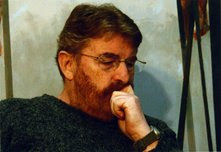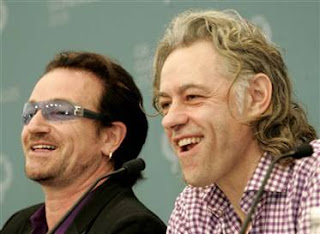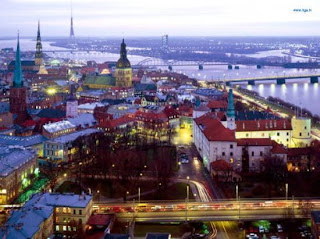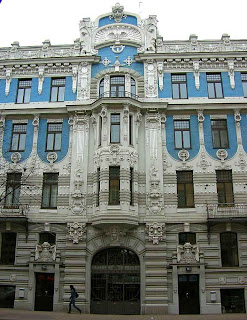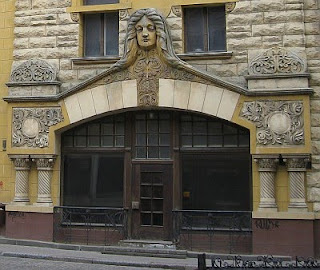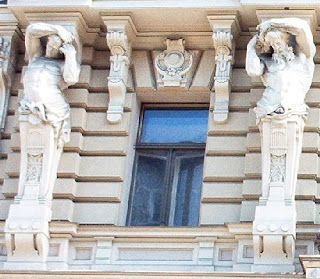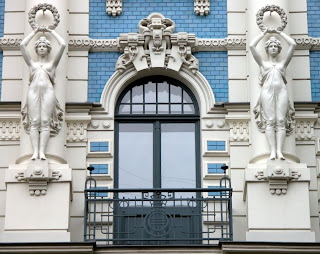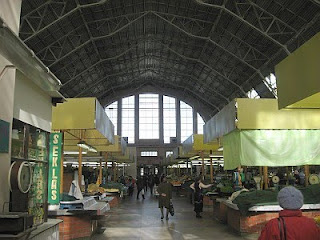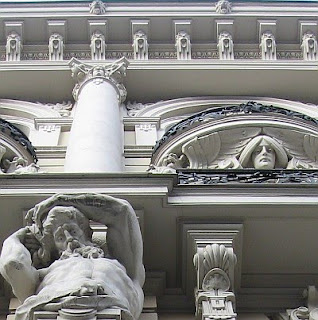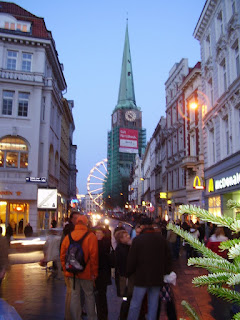 Xmas Market
Xmas Market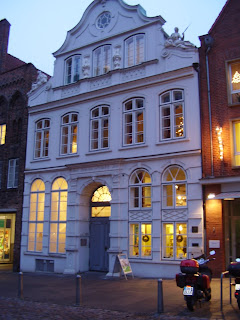 Buddenbrookhaus
BuddenbrookhausLübeck, The Queen of the Hanseatic League, was founded in 1143 as the "first German city on the Baltic coast". Surrounded by water on all sides, the old town has a historic centre dominated by seven church steeples. It was inscribed on the UNESCO World Heritage list because of its superb brick Gothic architecture. The remarkable Holstentor Gate is the defining feature of the Lübeck skyline. Built between 1464 and 1478 with walls which are 3.5m thick in places, it is one of the best-known and best-preserved town gates from the late Middle Ages and featured on the old German 5 Dm. banknote. The archaeological riches found beneath Lübeck old town have provided researchers with an important insight into medieval town life.
The UNESCO inscription reads;
"Lübeck – the former capital and Queen City of the Hanseatic League – was founded in the 12th century and prospered until the 16th century as the major trading centre for northern Europe. It has remained a centre for maritime commerce to this day, particularly with the Nordic countries. Despite the damage it suffered during the Second World War, the basic structure of the old city, consisting mainly of 15th- and 16th-century patrician residences, public monuments (the famous Holstentor brick gate), churches and salt storehouses, remains unaltered."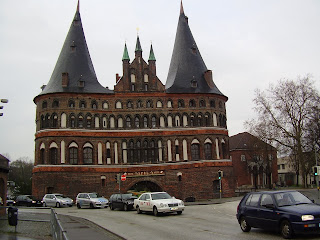 Holstentor Gate
Holstentor Gate Lübeck lies 41 miles (66km) north east of Hamburg, close to the Baltic coast. Not only is this historic town the home of three noted Nobel Prize winners, but as a living monument to the wealthy Hanseatic merchants of the 13th century, it sports some architectural treasures that have ensured its status as a UNESCO World Heritage Site. The town's famous sons were Willy Brandt, the West German chancellor who won the Nobel Peace Prize in 1971, and Thomas Mann, whose novel Buddenbrooks won the Nobel Prize for Literature in 1929. Günter Grass, who won the Nobel Prize for literature in 1999, is German author who made Lübeck his home
www.guenter-grass-haus.de/ 
He was born in the Free City of Danzig (now Gdańsk, Poland) of mixed Kushabian-Polish parentage. Since 1945 he has lived in (the now former) West Germany, but in his fiction he frequently returns to the Danzig of his childhood. He is best known for his first novel, The Tin Drum, a key text in European magic realism.
As far as the architecture goes, the town is known for its steeples and spires, high-gabled houses, strong towers and massive gates. Lübeck has a medieval atmosphere and many sites of cultural and historical interest: the Holsten Gate, St. Mary's Church, the town hall and historic administration building (Kanzleigebäude), alleyways and courtyards, the four-mast barque "Passat" that has become the symbol of Travemünde, the Hospital of the Holy Ghost and St. Peter's Church, whose tower offers awe-inspiring views over the town. The town is also billed as the world capital of marzipan, having been the spot where this delightful confection was first devised (there is a legend attached, of course). Samples of marzipan are freely available in Lübeck.
 Travemünde with the barque "Passat"
Travemünde with the barque "Passat"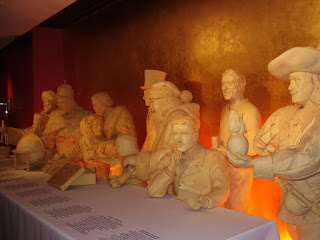 Niederreger Marzipan Museum
Niederreger Marzipan MuseumLübeck’s site was extremely promising - surrounded by the protective waters of the Wakenitz and Trave rivers, sailors were free to put off to the Baltic Sea from its shore. The city’s ruler sent his men to recruit merchants from Westphalia, from the Rhine, from Friesland and Saxony in order to help the newly-founded town blossom and flourish. But the town’s growth remained stunted in the wake of attacks, fires and conflicts between the city’s founder, Adolphus of Schauenburg and his lord, Henry the Lion. It was not until Henry the Lion refounded the city in 1159 that the project bore its first fruits.
The merchants of Lübeck set sail for the herring markets in Schoonen, reaching as far as Gotland in the 12th century and penetrating further into the Baltic’s, all the way to Novgorod: the path to Eastern Europe was finally forged. Further towns sprouted up near and around Lübeck: Wismar, Rostock, Stralsund, Greifswald, Stettin, Danzig, Elbing, Königsberg, Riga
http://daithaic.blogspot.com/2007/08/riga-capital-of-country-in-transition.htmlReval and Dorpat, all subject to Lübeck law. Thus Lübeck rose to head the Hanseatic League as the leader of the economic power in mediaeval times. The Hanseatic League had no navy of its own, no soldiers; it lacked an executive body and a separate budget. Nevertheless, merchants from the “Dudeschen Hense” were respected - and sometimes even feared - throughout the known world. Lübeck’s merchants maintained contacts reaching from the Orient to Venice all the way to Russia. The League set up branches in the most important cities - Peterhof in Novgorod, Stalhof in London, Deutsche Brücke in Bergen and Haus der Osterlinge in Brügge.
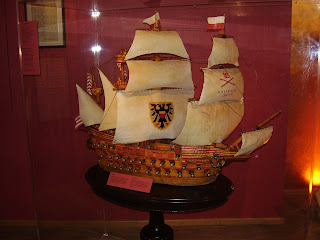

The merchant vessel called the cog was their preferred mode of transportation. Merchants climbed aboard these large trading vessels, braving wind, waves and pirates to bring their goods to their destination. Because the Baltic Sea was Lübeck’s lifeline, it is no surprise that the people of Lübeck, huddled safely as they are in the interior, still secured themselves a clear seaway - by purchasing Travemünde in 1329. When they acquired the hamlet for a mere 1,060 Lübeck marks, they had no inkling that it would one day become a large ferry port and a seaside resort with one of the richest traditions on the Baltic Sea.
In the 12th Century the merchants of Lübeck forged the trading links which led to formation of the Hanseatic League, at its height an entirely voluntary federation of 22 towns from Bergen in Norway to Novgorod in Russia which followed Lübeck Law and used the Lübeck Mark and the German tongue for trade. In the 13th Century this was the world’s wealthiest town at the centre of a vast trading empire of Hanseatic cities and 70 other associated towns controlling the trade in Baltic Herring, Salt, Amber, Timber, Furs, Wool, Cloth, Gold, Silver and precious stones. In the 13th Century to be a Freeman of a Town meant a great deal because you were not the Feudal vassal of a Lord and you were free to follow a trade, to live where you wanted and marry as you wished. “Town air is free air” was a saying of the time and the League took its name from the Hansestag, or Town Parliament and the towns were united by a strong sense of personal freedom and Civic duty in opposition to the aristocratic control which prevailed in the rest of Europe.
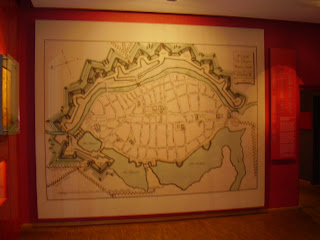 City Plan
City Plan
By the 1600s the influence of the league waned having been depleted by the Black Death, the 30 Years War and the rise of the Dutch. However its influence can be seen in the dominance of the maritime nations of North East Europe in world affairs driven by trade and domination of the sea routes in the latter half of the second millennium and today in the European Union which has many echoes of the Hansa past. The persistence of the ideals of personal freedom and free association cemented by trade of the Hanseatic League can be seen in the way the cities of the newly free Baltic countries have readopted their Hanseatic titles after gaining their freedom. In the 13th Century the Holy Roman Emperor made Lübeck a personal town of the Emperor, a title and independence from the surrounding province it maintained under the Kaiser until 1905.
During World War II, Lübeck was the first German city to be attacked by the Royal Air Force. The attack on 28 March 1942, first with incendiaries and then with high explosives, created a firestorm, that caused severe damage to the historic centre and destroyed three of the main churches and greater parts of the built-up area.
 Marienkirche
Marienkirche Dom - The aftermath of the RAF fire-bombing of Lübeck, Palm Sunday 1942
Dom - The aftermath of the RAF fire-bombing of Lübeck, Palm Sunday 1942In the church of St.Jakobi you can see a plaque in German to the more than 1,100 children of Lübeck who were “martyed” on Easter Sunday 1942. In fury at this medeveal gem so important to German Culture being bombed and the deliberate targeting of civilians, Hitler ordered the so called “Baedeker Blitz” on historic British towns and soon Exeter and others felt the brunt of the Luftwaffe’s revenge. The POW camp for officers Oflag X-C was located near the city from 1940 till April 1945. At the end of the war one of the biggest disasters in naval history happened in the Bay of Lübeck when Allied bombers sank three ships which, unknown to them, were packed with concentration camp inmates being transported to an execution site. About 7,000 people were killed and to this day this remains the worst loss of life in a civilian maritime disaster. Lübeck was occupied without resistance by the British Army at the end of the war.
 Dom
DomAfter the war the Iron Curtain was not an abstract term but a concrete and steel reality which ran through the suburbs of Lübeck and tore it from half its hinterland whilst the town increased in size swollen by refugees. Today you will find a confident UNESCO World Heritage site rebuilt in some style after the ravages of war, a major University and Medical centre for North Germany and a town revitalised by German reunification, a major summer resort in Travemünde and a busy port revelling in the restoration of the Baltic trade routes.
www.luebeck-tourism.de/ Very few cities can lay claim to changing the course of history and the shape of the modern world. Welcome to one which can, welcome to this unique and special place, Wilkommen to The Imperial and Free Hanseatic City of Lübeck.
 Day 1
Day 1Take the airline run by an Irish Accountant
www.ryanair.com and land at Lübeck Blankensee Airport
www.flughafen-luebeck.de/ which is 8km from the town. When the writer first came here (On a day trip!) in 2000 the schedule was Ryanair in the morning, Ryanair in the evening. Today Ryanair operate from Blankensee to 6 locations and the Hungarian airline Wizz operates to a further 5. One of the reasons the airport is still here is that the former airbase was bought and is still personally owned by the Tui family who live nearby and who own Thomson Tours and the leading travel operators in most European countries. Take a taxi directly to the Ibis Hotel on Fackenburger Allee.
After you have settled in to your hotel take a gentle stroll downtown to orientate yourself and soak up the atmosphere of the Weihnachtsmarkt, the Christmas Market. Turn left down Fackenburger Alle towards the centre, Der Centrum, and soon you will come to a roundabout at Linden (Lime tree) Plaz merrily lit up with Xmas lights. Head past the Holstentor Gate across the bridge on the River Trave and straight up Holstenstor Allee. At the top you will come to Der Markt in front of the Town Hall (Der Rathaus) and the massive church of St. Marien. Here and along Breite Strasse (High Street) there will be all the fun of the Xmas Markets and don’t worry about eating as many of the stalls are food stalls where you can enjoy a real hot dog and much more! Cold? Try a hot Glühwein and if you want it stiffened with schnapps or rum ask for it “mitt strob” or made with non alcoholic wine ask for it “Spiritus frei”. Behind St. Marien you will find the enchanted forest in the Churchyard and at the end of Breite Strasse you will find the square called Koberg with the Big Wheel in front of the Heilegen-Geist-Hospital. Now, having got your bearings and soaked up the atmospherics take a cab back to the hotel and get an early night, tomorrow is a busy day! Gute Nacht!
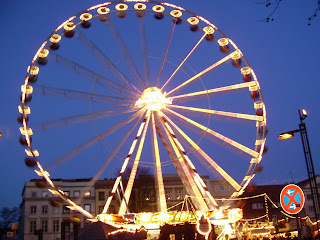 Koberg Big Wheel
Koberg Big Wheel Weinachtsmarkt
WeinachtsmarktDay 2 – Herzlich willkommen auf dem Lübecker Weihnachtsmarkt - Five Christmas and Arts & Crafts fairs invite you into the Old Town of Lübeck. Now for the serious Christmas Market stuff! Thousands of fairy lights and Christmas decoration in the streets and shop windows create a festive atmosphere all over the city. More than 200 stands in the Old Town of Lübeck offer toys, Christmas tree decoration, craftwork and a lot of other things. The historic fairs, the fairytale forest at the churchyard of St. Marien and the big wheel at Koberg are a special attraction.
www.luebecker-weihnachtsmarkt.de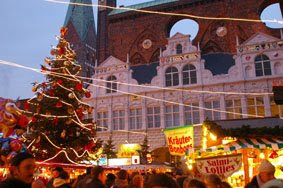
 Pick your sausage!
Pick your sausage!After breakfast, frühstück, retrace your path of the night before into town. As you come close to the Holstentor Gate you can contemplate the view of Lübeck, the spires of the churches of St. Petri, St. Marien, St. Jakobi, the sailor’s church, The Dom (fr. latin, Domus Dei, House of God), St. Katharien and St. Aegidien, the guild church, and Herz-Jesu, the catholic cathederal. By the Holstentor Gate you will find the tourist office and in the gate the town museum. To the on this side of the river by the Willy Brandt Alle you will find the site of “Ice World” for tomorrow. As you cross over the Trave river on the Holstenstorbrucke turn right on to the Obertrave quay. Here opposite the Salzspeicher, the salt warehouses, if the port is not frozen take a boat trip to get a unique perspective of this island town, its port and the back waters of the Wallhafen and Hansahafen. (about 1 hour). Tour of the city, port and canal: City-Schifffahrt - Departure: at An der Obertrave (Musik- und Kongresshalle events center) and 2 piers at An der Untertrave, every half hour.
www.cityschifffahrt.de
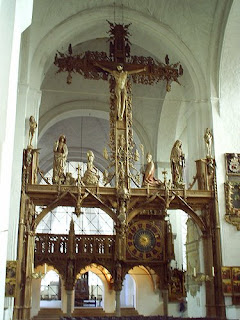 Triumphkreuz, St. Jakobi
Triumphkreuz, St. Jakobi Near St. Petri you will also find the Museum für Figurentheter, a wonderful puppet museum and theatre. Frau. Saraswati Fey, the proprietor’s wife is a lovely Indian lady who told me on my first visit that her daughter worked in London at Harvey Nichols and then asked “is it respectable?” What could I say? As well as the wonderful collection it gives an excellent inside view of typical Lübeck merchant’s houses.
http://www.figurentheater-luebeck.de After the boat trip head up from Obertrave to the nearby St. Petri Church along Petersgrube. St. Petri, 800 years old, opens its doors to the more than 50 craftsmen and women offering a wide variety of traditional and contemporary gift ideas, created by artists from Northern Germany. Stroll through the festively decorated church and admire toys, leather, soap-stone, pewter, ceramics, wood, clothing made from natural fibres, woollen accessories, felt, jewellery, glass and amber, and water-colour paintings. Refreshments are served in the medieval courtyard. There is nominal entry fees which goes to charity and afterwards go up the 50m high tower by lift for a spectacular bird’s eye view of Lübeck.
 Petrikirche Nave
Petrikirche Nave

 Rathaus Cellars
Rathaus CellarsIts lunch time! For a special treat and an atmospheric introduction to the cuisine of Schleswig-Holstein got through the Markt and underneath the 13th Century Rathaus you will find the Rathaus Cellars. Follow the locals and go down the stairs and you will find a wonderfully warm restaurant with flag floors, brass chandeliers and huge beer barrels – enjoy a hearty and good value lunch! Afterwards go into the Rathaus and view this fine civic building, a secular palace representing both the independence and civic pride of the Hanseatic merchants and townspeople of Lübeck. Now for a special treat. Double back along the front of the Markt to Café Niederegger. Lübeck's reputation as the "marzipan capital" stretches back to 1800. In truth, no one really knows whether marzipan was the brainchild of a particularly talented and clever confectioner or the product of a contest among the then-famed confectioners of Lübeck. The quality of the confection depends on how and in what proportions the individual ingredients are mixed together. There are quality regulations that define the quality of the almonds and limit the amount of sugar that can be added - by tradition very low in Lübeck. Upstairs at Café´Niederegger is the marzipan salon (free entry), where visitors can learn all about marzipan. The twelve life-size marzipan figures are particularly impressive. In the café at the back of the always busy shop selling a vast array of marzipan products on the ground floor enjoy a marzipan nut cake or traditional stolen with a delicious marzipan cappuccino.
More information at
www.niederegger.de Head back down towards Koberg and on the north side of the square you will find the Heilegen-Geist-Hospital.
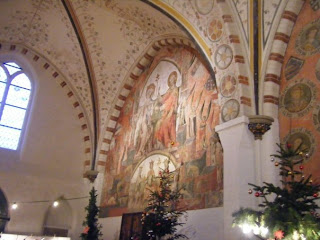
 Heilegen-Geist-Hospital.
Heilegen-Geist-Hospital.
Now on Koberg find the Arts & Crafts Fair in the Hospital of the Holy Spirit. In the unique setting of this former abbey and almshouse for senior citizens more than 150 artisans from throughout Germany, Scandinavia, and the Baltic States, exhibit their arts and crafts under one vaulted roof. Here you will find ceramics, wood, textiles, silk-design, felt, glass & crystal, jewellery, amber, watercolour paintings and cards, etc. Fresh homemade waffles, delicious cakes and beverages, wine and cheese, hot-spiced punch, soup and open-faced sandwiches invite you to linger whilst seasonal music performances create a yuletide feel. On December 10th pastor Baltrock will give readings at 6pm at the cloister. This unparalled Christmas fair is, hosted by the members of "Frau & Kultur, eV. “ group Lübeck, and the net proceeds are donated to various social and cultural charities in Lübeck. Afterwards wander back through the stalls and take a ride on the Big Wheel in Koberg for a view of the port and the Xmas fairs all around you.
Day 3On this the Second Sunday of Advent at 10.00 am you must be at the church of St. Mary’s (St. Marien)
www.st-marien-luebeck.de to experience a Lutheran Advent service in a great Baltic Brick Gothic Cathedral.
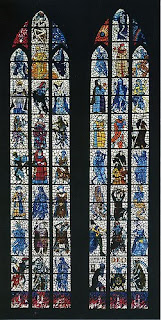 Alfred Mahlau (1955-56) - Dance of Death window, Marienkirche
Alfred Mahlau (1955-56) - Dance of Death window, Marienkirche Altar
Altar 
St. Mary’s is the church of the council of Lübeck and the 3rd biggest church in Germany. She is the archetype for many gothic churches in the whole Baltic area. St. Mary’s houses much artwork, for example the "Triumphkreuz" of Gerhard Marcks (1945), as well as the biggest mechanical organ in the world. From 1667 till 1707 Dietrich Buxtehude, the famous church musician and composer, was the organist in St. Marien. The teachings of Martin Luther and the Reformation were enthusiastically embraced by the burghers of Lübeck who were attracted the freedom of thought and lack of outside interference it offered which resonated with their civic values. Former catholic churches like St. Marien were stripped of their decoration and today their interiors give a unique resonance to the music of the Organ and the Chorale. The Pulpit is always in the middle of these churches so all can hear the word.
 Astronomical Clock, St. Marien
Astronomical Clock, St. Marien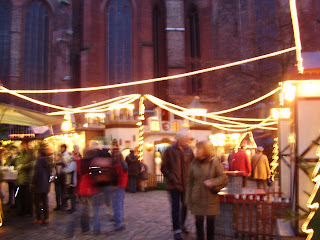
Afterwards head down Beckergrube to the Untertrave quayside and turn left along the quay to the Holstentor past the sailing barques & schooners and cross the river by the gate to Ice World 2006. Enjoy the frosty and fascinating atmosphere of Ice World in the “Christmas city of Northern Germany”. Together Ice World and the skating rink will turn the famous scenery of the medieval old town into glittering dreamworld made of snow and ice. This year Ice World takes place directly at the Music and Congress Centre at the Trave river, Willy-Brandt-Allee, on an area of 800 square metres in a special thermal tent with a constant temperature of 8 C below zero. This temperature is necessary to keep in shape those frosted works of art, some of them with a height of 6 metres. A combination of special lighting and the reflection from snow and ice will present the works of art in a stunning colourful splendour. The statues will be made of 150,000 kilos of ice and 200 m³ of snow by an international team of ice artists. Tip: When visiting Ice World do not forget to bring warm clothes. And after your visit to the amazing world of ice sculptures you can enjoy the cosy winter village offering hot spicy wine, coffee and hot chocolate. The large ice-skating rink with a surface of approximately 600 square metres offers fun on ice.
www.iceworld.de/content/blogcategory/19/113/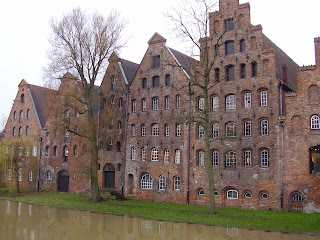 Salt WarehousesDay 4
Salt WarehousesDay 4 For this your final day you should have got your feet. If you have not done so head up to the other end of town to the Dom, The Cathedral of Lübeck.
www.domzuluebeck.de This romantic building is the oldest monument in Lübeck. After the city became diocesan town in 1160 Henry the Lion started to build this enormous church building. The Cathedral of Lübeck contains much fine artwork including the 17 metres high "Triumphkreuz" of Bernt Noke (1477). The astronomical clock still runs on its original clockworks with the original movement till today. Nearby is the must see St. Annen Museum. Enjoy a guided tour at St. Anne's and find the answer to the question: why do we set up a Christmas tree? Back into downtown and make sure behind St. Marien you find Budden-brookhaus
www.buddenbrookhaus.de to both gain an insight into the world of the great writer Thomas Mann and his brother and to see the largely Victorian interior of a prosperous merchant’s house. Buddenbrooks has now been made into a major movie featuring Lübeck as a magnificent backdrop.
http://daithaic.blogspot.com/2008/12/buddenbrooks.html
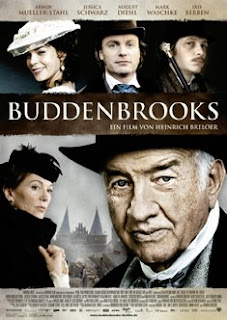
Other shopping and sight seeing opportunities are:
Shopping and Dining in LübeckTake time to discover: Heick + Schmalz (salt loft) where the historic salt granary now displays fine clothing for the entire family. Modifications were carried out at the Town Hall Arcades which now house retail shops and a café. Strolling along the specialty shopping streets, such as the Fleischhauerstrasse or the Hüxstasse, one is charmed by the variety of buildings and facades spanning the Gothic, Baroque, and Classicism periods. Karstadt with the largest downtown restaurant also boasts Lübeck’s longest fish and cheese stand. The Linden Arcades, centrally located at the main train station, offers everything from electronics to whole foods.
Two of the myriad examples of fine dining in Lübeck are the "Schiffergesellschaft" and the "Schabbelhouse". Germany´ s oldest restaurant, "Schiffergesellschaft", across from St. Jakobi, is a favourite not just for sea farers. The Schabbelhaus at Mengstrasse, artfully restored, serves delicious lunch and dinner specialties in a relaxed and charming atmosphere
 Museums in the Old Town of Lübeck
Museums in the Old Town of LübeckLübeck is an important cultural centre and especially at Christmas time a visit to the Christmas fair should be combined with a visit in one or more of the town’s museums. Enjoy the quiet and reflective atmosphere and the unique combination of historic buildings and interesting exhibitions.
www.museen.luebeck.deDiscover the diverse expressive output of the author Günter Grass at the Günter Grass house
• Experience the "small MoMa" in the art hall with works by Picasso, Beckmann and others
• Discover the nativity traditions of other nations at the Völkersammlung
• Get fascinated by the topic of "biotechnology" and learn about beer, cheese and penicillin (!) at the museum of nature and environment
• Walk around the most important cloister of Northern Germany, the Burgkloster, and visit the permanent exhibition "every day life in the Middle Ages in Lübeck"
• Visit the Holstentor museum, and review the rise of Lübeck as the queen of the Hanse
• Enter one of the most beautiful merchant houses, the Behnhaus / Drägerhaus, and be fascinated by the paintings of Caspar David Friedrich, Max Liebermann and others
• Experience the church museum St. Katharinen or visit the Herrenwyk to find out more about life and work in the 20’s and 30’s.
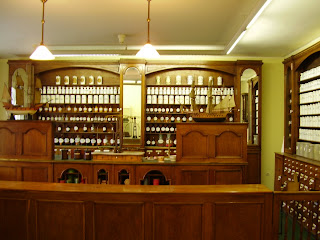 St. Annen Museum ApotcheraryHOTELS
St. Annen Museum ApotcheraryHOTELS.
Budget 2* - Ibis Hotel, Altstadt in Laufweite, www.accor.com
Traditional 3* - Hotel Lindenhof, Altstadt in Laufweite, www.luebeck-tourism.de/static/onlinebuchen/index_l.html
Luxury 4* - Hotel Radisson Senator, Altstadt in Laufweite, www.senatorhotel.de/start_.asp?is=2 travel
travel





